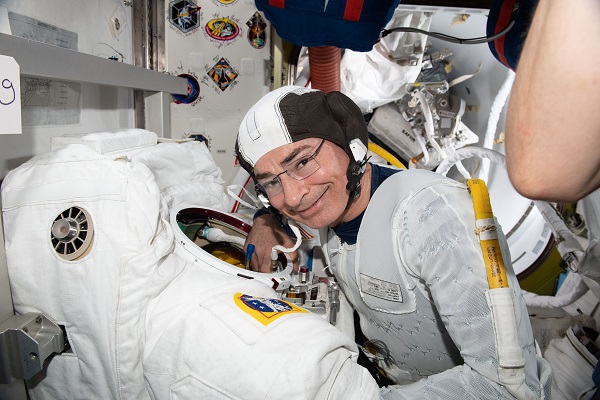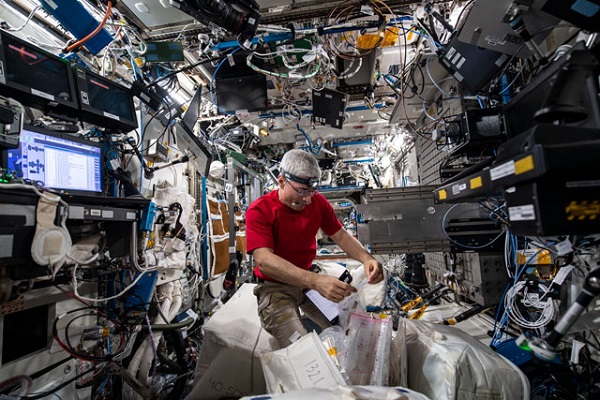NASA astronaut Mark Vande Hei is returning to Earth after living in space for 355 days, the record for the longest single spaceflight by a NASA astronaut. Vande Hei surpassed former NASA astronaut Scott Kelly’s 340-day record on Mar. 15, 2022. This extended mission aboard the International Space Station provides researchers an opportunity to observe effects of long-duration spaceflight on the human body as the agency makes plans to return to the Moon under the Artemis program and prepare for human exploration at Mars. During his record-setting mission, Vande Hei spent many hours on scientific activities aboard the space station, conducting everything from plant research to physical sciences studies.
Here is a look back at some of the research Vande Hei conducted in microgravity.
Download full-resolution versions of all photos in this article.
Studying muscle loss
Vande Hei collects microscopic images of cell cultures for the Cardinal Muscle investigation. Muscle mass diminishes with age on Earth, a condition called sarcopenia. Astronauts experience similar but accelerated loss of muscle mass during spaceflight. This study tested whether engineered tissues cultured in space could provide a model for studying muscle loss and assessing possible treatments prior to clinical trials. Countermeasures to treat muscle loss experienced by crew members become more important as mission length increases. A tissue engineered model also could enable further study of muscle deterioration in people on Earth and provide a platform for testing potential treatments.
Immune response in space
The Celestial Immunity investigation builds on earlier studies of the human immune response using blood cells from both elderly and younger adult donors to examine how microgravity affects overall human immune function. The investigation could support the development of new vaccines and drugs to prevent and treat existing and emerging human diseases. Here, Vande Hei works on the investigation in the Life Sciences Glovebox (LSG), a sealed facility for life science and technology investigations that creates an environment much like a typical workbench in a ground-based lab.
Exposed experiments
Working with astronaut Thomas Pesquet of ESA (European Space Agency), Vande Hei installs an experiment platform to be placed outside the space station in the harsh environment of space using the Japan Aerospace Exploration Agency (JAXA) JEM Small Satellite Orbital Deployer (J-SSOD). The ability to place materials outside the space station enables a variety of scientific experiments and technology demonstrations. These studies include a series of Materials International Space Station Experiment or MISSE investigations, which have exposed seeds, concrete, solar cells, microbes and more to space.
Fire safety
Vande Hei installs Solid Fuel Ignition and Extinction (SoFIE) hardware inside the Combustion Integrated Rack (CIR) in preparation for a pair of fire safety experiments. SoFIE-MIST examines thermally assisted burning in microgravity. Results could help determine the best methods for extinguishing fires in space and inform selection of safer materials for future space facilities. SoFIE-GEL, which measures heating in a fuel sample, also could contribute to optimal fire suppression techniques. Additional experiments are planned that will use SoFIE hardware in the future.
Keeping an eye on astronaut health
Through the 21 years humans have lived and worked on the space station, studying and maintaining the health of those humans has been a priority. NASA’s Human Research Program (HRP) is dedicated to discovering the best methods and technologies to support safe, productive human space travel. Here, Vande Hei peers into near-infrared medical imaging gear, or optical coherence tomography, for detailed views of his retina as part of regularly scheduled eye checks for crew members.
Harvest time in space
On future long-duration missions, crews will grow food to supplement what they bring from Earth. Researchers have used the space station to study the challenges of growing plants in microgravity, examining the formation and growth of roots and leaves, analyzing genetic changes, and testing growth and watering systems. During Vande Hei’s time on station, he participated in the first (and second) harvest of chile peppers grown in space for the Plant Habitat-04 study. The top image shows Vande Hei with NASA astronauts Shane Kimbrough and Megan McArthur and JAXA astronaut Akihiko Hoshide as they share some of the peppers. The APEX-7 investigation analyzed the role of RNA regulation on gene expression during spaceflight in both roots and shoots of plants. In the bottom image, Vande Hei harvests APEX-7 seedlings to prep for analysis.
Going for a (space)walk
Vande Hei checks the fit of a spacesuit prior to a spacewalk in June 2021 that continued installation of a third Roll-Out Solar Array (iROSA) outside the space station. NASA astronaut Shane Kimbrough and ESA astronaut Thomas Pesquet conducted the spacewalk with Vande Hei commanding the robotic arm to maneuver the astronauts and array to the installation location. The new solar arrays increase the station’s total available power from 160 kilowatts to a maximum of 215 kilowatts. The same solar array design will be used to power elements of NASA’s Gateway lunar orbiting outpost.
Kidney health
Vande Hei works in the LSG on Kidney Cells-02, an experiment that uses a 3D kidney cell model or tissue chip to study the effects of microgravity on formation of microcrystals in kidney tubules. In microgravity, these microcrystals are expected to remain evenly suspended, allowing better observation of their effects. Astronauts living in microgravity can experience dehydration, reduced activity, and bone demineralization, all conditions that contribute to formation of kidney stones. Results could support design of better treatments for kidney stones, osteoporosis, and other conditions for astronauts and people on Earth.
A better way to go
Vande Hei swaps out components on an advanced new toilet installed inside the space station’s Tranquility module. The hardware is part of the Universal Waste Management System (UWMS), a demonstration of a more compact toilet and a Urine Transfer System (UTS) that allows simultaneous use of both the station’s toilets. The system also automatically offloads backup storage, saving crew member time. A smaller, more comfortable, and more reliable waste-disposal method allows the crew to focus on other activities. In addition, a smaller footprint and improved technology support future exploration missions, including the Gateway lunar outpost.
Tiny particles, big results
The InSPACE-4 experiment studies the assembly of tiny structures from colloids – suspensions of particles in liquid – using magnetic fields. This approach changes the properties of the resulting material, including its mechanical response to and interaction with light and heat. In microgravity, scientists can observe the assembly process without confining sample walls and for longer timescales not possible in simulated microgravity. Results could help researchers harness nanoparticles to fabricate and manufacture new materials for use on Earth and in space. Here, Vande Hei sets up experiment hardware inside the Microgravity Science Glovebox (MSG).
Bubbles and boiling
In this image, Vande Hei sets up for the Flow Boiling Condensation Experiment (FBCE) investigation. Previous studies have shown that the process of boiling, including bubble formation, works differently in microgravity. FBCE examines a model for a heat management system based on boiling processes. Results could support improvements to important systems for space exploration, including thermal control and management systems for vehicles and planetary habitats and storage and transfer of cryogenic liquid fuel. The work also could increase the life of boilers for industry on Earth.
Best view off the planet
Vande Hei holds a camera as he peers through the station’s hatch window. Crew members use hand-held cameras to take photographs for Crew Earth Observations (CEO), which records how the planet changes over time, supports scientific research, and helps monitor dynamic events such as hurricanes, floods, and volcanic eruptions. Crew members have been photographing Earth from space since the Mercury missions beginning in 1961. Vande Hei took this image of frozen Achit Lake, in the Altay Mountain range of Mongolia, as the station orbited 266 miles above it.
Remote manipulation
Ultrasonic Tweezers, an ESA investigation, tests capturing and manipulating objects remotely using sound waves. The ability to move objects without physical contact could help avoid contamination during future exploration of planetary surfaces. On Earth, trapping and isolating objects in this way could allow researchers to study objects in detail without touching and potentially contaminating or corroding them. Here, Vande Hei assists ESA astronaut Matthias Maurer (out of frame) during operations for the experiment.
Download full-resolution versions of all photos in this article.
Learn more about the station’s history of crew members here. For daily updates on science aboard the space station, follow @ISS_Research, Space Station Research and Technology News or our Facebook. For opportunities to see the space station pass over your town, check out Spot the Station.
Melissa Gaskill
International Space Station Program Research Office
Johnson Space Center









































